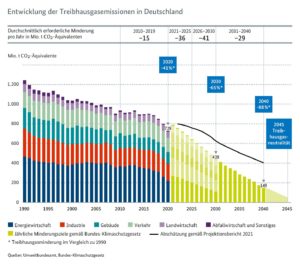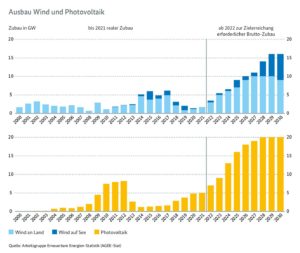On 11 January 2022, Economics and Climate Protection Minister Robert Habeck presented the opening balance sheet on climate protection to show where Germany stands in terms of climate targets in the various sectors, the expansion of renewable energies and grid expansion. The opening balance sheet shows how far climate protection is behind expectations. Germany is starting with a drastic backlog, and the climate protection measures taken so far are insufficient in all sectors. As a result, the 2022 and 2023 climate targets will be missed. Increased efforts are to make up for the shortfall. To achieve this, the speed of emission reductions must be tripled and significantly more must be done in less time.

By 2030, the share of renewable energies is to be increased to 80 % and by 2045 Germany wants to become climate neutral. The priority laws, regulations and measures are now being "put on track" - a first climate protection package will come by the end of April, a second in the summer. The goal of the immediate climate protection programme is to bring all sectors onto the target path and to initiate the necessary measures so that Germany can achieve its climate goals. All the necessary laws, ordinances and measures are to be completed by the end of 2022. To ensure that this succeeds, the Federal Government will consistently push ahead with the preparation and implementation of the programme. Economics and Climate Protection Minister Robert Habeck made it clear: "All of this is a mammoth task. And it will take several years before we see the successes. But what we are doing now lays the foundation for bringing climate protection and prosperity together." The current developments in Russia and Ukraine have given this topic a new dynamic.
The immediate measures that the Federal Ministry for Economic Affairs and Climate Protection will present in a timely manner include:
EEG amendment: In order to be able to achieve the 80% renewable electricity generation by 2030, the government wants to increase the tender quantities in the Renewable Energy Sources Act (EEG). The technology-specific quantities would be designed on an increasing basis - starting from a very ambitious level from the outset. The gross electricity consumption in the middle of the corridor from the coalition agreement (680 to 750 TWh) is 715 TWh. The principle that RE expansion is in the overriding public interest and serves public safety is to be anchored.
Solar energy: Through the solar acceleration package, the government wants to unleash solar energy. The solar acceleration package will contain a broad bundle of individual measures to significantly advance solar energy. These include, among other things, an improvement in tenant electricity, an increase in the tendering thresholds and an opening of the area for ground-mounted systems, taking into account nature conservation criteria. In addition, the new goal that all suitable roof surfaces are to be used for solar energy in the future is to be implemented in law. Solar energy will be mandatory for new commercial buildings and the rule for new private buildings.
Wind energy: Potential areas for onshore wind are to be developed in the short term and the expansion process accelerated with a wind-onland law. The government wants to reduce the distances to rotating radio beacons and weather radars and implement measures for better compatibility of wind expansion with military interests. Large areas of potential land are available here. In the area of radio navigation and rotating beacons, 4 to 5 GW of additional capacity are possible. In the area of military interests, the potential is 3 to 4 GW of capacity. Two per cent of the state's land area is reserved for wind energy with the Wind on Land Act, wind energy expansion is to be reconciled with species protection and the conditions for speedier planning and approval procedures are to be created.

The diagram shows the slump in 2021 and the increasing expansion to meet the climate targets.

This diagram also shows that the current expansion is not sufficient to achieve the goals.
Reducing the price of electricity: The basis for more renewable electricity at competitive prices will be created. Electricity is to become cheaper, especially in comparison to fossil energy sources. The government wants to make heat pumps and e-mobility more attractive and promote sector coupling. The EEG levy is to be financed via the federal budget from 2023 onwards in order to relieve consumers of electricity costs.
By abolishing the EEG levy, the levies linked to the special equalisation scheme (KWKG, offshore grid levy) will be transferred to a separate law, which should give industry a reliable and plannable legal basis for the remaining levies.
Climate protection contracts with industry: The legal and financial prerequisites for the provision of climate protection contracts for difference as a central instrument for supporting the transformation in industry are being created. Industry needs a reliable funding and investment framework for entering climate-neutral production processes. This will make climate-neutral production processes economically viable sooner and make costs more predictable for companies.
Heat strategy: The Federal Minister of Economics is aiming for a very high share of renewable energies for the entry into climate-neutral production processes: 50% of heat is to be produced in a climate-neutral way by 2030. Energy efficiency is seen as the second pillar here, so the government wants to develop a new "climate neutrality" building strategy for the optimal interaction of both instruments. Climate protection in buildings will be decisively advanced by the government, and it will advocate comprehensive municipal heating planning as well as decarbonisation and the expansion of heating grids. To this end, the federal subsidy for efficient heating grids (BEW) will come into force immediately after approval under state aid law and its funding will be increased.
Building standards and promotion: Together with the Federal Ministry of Housing, Urban Development and Construction is expected with a speedy revision of the Building Energy Act (GEG) created a reliable planning basis for investments in order to bring new buildings and building renovations towards the goal of climate neutrality in 2045 with a focus on significantly reduced energy demand. This implements the agreement from the coalition agreement that from 2025 every newly installed heating system will be operated on the basis of at least 65 % renewable energies. This is to prevent bad investments that are not compatible with the climate goals. The federal support for efficient buildings will be adapted quickly in parallel; it is intended to flank the new requirements of the Building Energy Act and to bring the market into line with these steps by 2025 through efficient incentives.
Hydrogen strategy: The existing measures for the market ramp-up of hydrogen technology will be adapted to double the production of green hydrogen compared to previous plans. The National Hydrogen Strategy will be revised this year and additional funding programmes will be launched.
Minister Habeck emphasised on 11 January 2022 that this was only a first selection of the planned projects. At present, it is being examined which further measures can be quickly launched. In addition, further measures from other ministries and sectors are to be included in the emergency programme, which will be developed in the coming months in close cooperation within the federal government.
The MuP Group is helping to achieve compliance with climate targets as part of "Engineering for a Better Tomorrow". Through M&P GO.BLUE.NOW, the limitation of global warming to 1.5° is pursued together with customers and partners.
Links to sources:
https://mup-group.com/mull-und-partner-gesellschaften/#gobluenow


